Eeling in Warriewood's Creeks
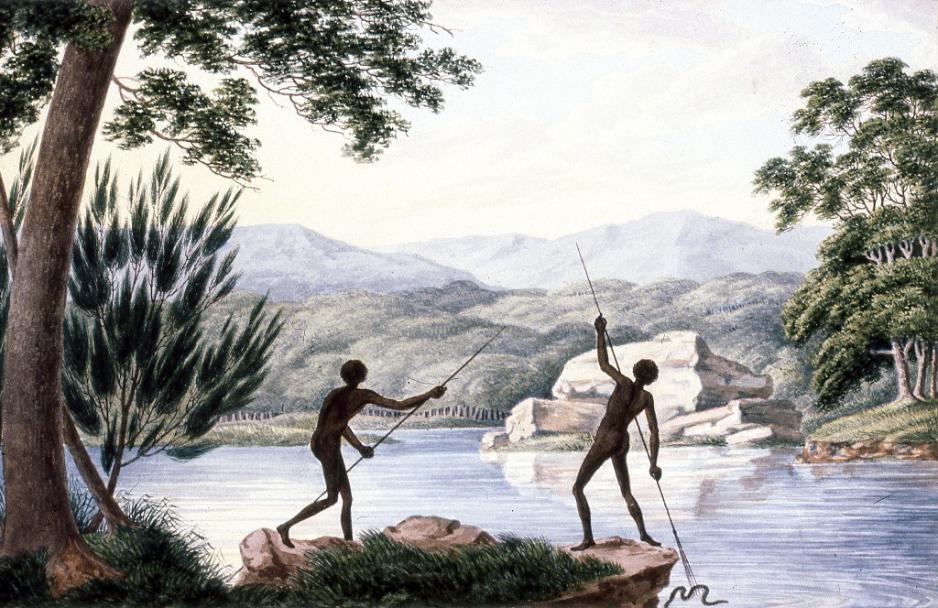
Two Aborigines spearing eels, circa 1817, by Joseph Lycett, , approximately 1775-1828. Image No.: nla.pic-an2962715-s10, courtesy National Library of Australia.
Eeling in Warriewood's Creeks - The Firm Ways to Make A Pristine Environment Tangible Even During Slippery Times
During the past few weeks we seem to be meeting people who keep pointing to what they have seen as large eels in our creeks - it seems these slippery creatures have not been affected by increased urbanisation and all the runoff from chemicals treating gardens that makes its way through our stormwater drains to the sea. This prompted an investigation into how long we may have been procuring and eating eels as a food source to which the answer clearly is - as long as people have lived here and been hungry.
A book to be released this week, which we shall run more on in Issue 187, True Light and Shade: An Aboriginal Perspective of Joseph Lycett's Art by Professor John Maynard shows 'Two Aborigines Spearing Eels' on page 65 while Professor Maynard explains that both saltwater and freshwater eels were a prized delicacy and abundant in creeks as well as waterways like lagoons. They were caught using traps and by pronged spears.
Early European settlers also came from a long line of eel eaters and brought the taste with them -
Aboriginal peoples have left a few Scarred Trees and numerous engravings in the Warriewood valley-Ingleside escarpment, the least worn in Warriewood being a series of eels and a spear, are to be found near Narrabeen Creek. John Ogden, who contributed a history page on Petroglyphs, spoke of the sacred rituals associated with these images. These places were revisited in the seasons the creatures they represent would flourish or be due to arrive in and would be re-carved, or the grooves deepened, as part of 'singing in' the songs of, in this case eels and eel hunting. These were sacred ceremonies.
The Short Finned Eel Anguilla australis and Longfinned eel Anguilla reinhardtii both do well in areas of lower water velocity and are common and widespread in coastal river systems and streams in New South Wales. Mature adults migrate from fresh water to the sea in order to spawn with the new 'elvers' being around three years old before they return to fresh water and upstream, usually in the Autumn. They eat fish, insects, yabbies, frogs.
Many who work with eels state the elvers will mostly treturn to streams and rivers their parents swam in, some kind of genetic coding is indicated as the reason for this. The other interesting fact connected with Longfinned eels is that they start their lives as eggs in the Coral Sea off New Caledonia or New Guinea in deep water from 300 to 3000 meters down. Female eels can spawn up to 20 million eggs, although this only occurs once and then she dies. From there the eggs drift with the currents, hatching into leaf shaped larva that drift, float and swim until they hit the East Coast of Australia. As they reach the coast and the water quality changes the leaf shaped larvae transform into glass eels which are a clear tiny baby eel.
As these baby eels drift down the coastline of Australia they enter the river systems and migrate upstream. When they first enter the rivers they are called glass eels as they are very small and clear (see through). Once they enter fresh water and start feeding they become pigmented and darken in colour and are called elvers.
Eels getting into Warriewood creeks would come through Narrabeen Lagoon. Eels in Careel creek, and apparently two witnesses spoken to separately have watched a large one there on more then a few occasions, would find their way to the creek through the Pittwater estuary. Eel farmers and those who grow these through aquaculture for food markets state;
'eels will stay from 10 – 30 years in your dam and then in flood conditions migrate back to sea to breed and then die. Long finned eels have been known to grow to over 80 kgs in size and live for 60 years. When these adult eels migrate back to the sea they actually change shape. The head flattens and the eyes broaden around the head.' - Eels - by Rob McCormack, NSW Aquaculture Association Inc., retrieved from nswaqua.com.au/fish-species/eels
Many people state that these larger eels may be responsible for the disappearance of ducklings on our creeks. Eels remain a commodity for seafood lovers in New South Wales, their peak season is November. Wild eels sell for around $18.00 a kilo currently while live farmed eels fetch from $10-$18 a kilo.
In the past:
FISH MARKET. A fair supply of fish was received at the Woolloomooloo markets to March 28, including the following :-From the harbour, 55 baskets: Broken Bay, 134; Botany, 146;Lake Macquarie, 66; Narrabeen, 12; Port Stephens, 271 ; Shoalhaven, 10 ; Ulladulla, 4 ; total, 688 baskets. Also, from the harbour, 1 basket prawns and 6 dozen kingfish; Broken Bay, 30 dozen schnapper ; Jervis Bay, 6 bags oysters, 7 dozen schnapper, and 9 dozen traglin ; Port Stephens, l8 bags oysters; and Long Reef, 14 dozen schnapper, 13 dozen sweep, and 4 dozen traglin. Underweight, a-half basket was sent to the charitable institutions; 20 baskets were condemned as unfit for food. The prices range as follows: Schnapper, 9s. to 42s. per dozen; squire, 4s. to 8s. ; flat-head, 2s. to 14s.; whiting. 2s to 8s. ; flounders, 3s. to 9s. ;roles, 3s. 6d. to 7s. ; kingfish, 6s. to 27s. ; jewfish, 3s.to 54s.; groper (black), 18a.; traglin, 6a. to 14s.; nunnegai, 6s.; salmon, 5s. to 6s. ; mullet (sea), 4s. to 9s. 6d. ;long toms, Is. to 2s. 6d. ; rock cod, 3s. to 6s. ; eels, 6s. to 12s. ; bream (red), 10s. to 23«. per basket, 801b. to 901b. ;bream black-*, 10s. to 46*. ; garfish, 7s. to 42s. ; blackfish,10s. to 23s. ; silverbellies, 7s. to 9s. ; mullet (sand), 8s.to 24s. ; travelly, 9s. to 15s. ; yellowtail. 6s. to los. ;tailers, 8s. to 17s. per basket : crabs, 3s. to 18s. per dozen ; prawns, 9s. to 35s. per bushel ; oysters, 18s. to 42s. per bag; amount realised, £613 1s. 3d. FISH MARKET. (1885, April 2). The Sydney Morning Herald(NSW : 1842 - 1954), p. 11. Retrieved from http://nla.gov.au/nla.news-article13582486
There are very large eels in the fresh water at National Park. Anglers do a good turn to the small fish when they take out a big one. Perch are being caught in the Hawkesbury, near Windsor. FISHING NOTES. (1907, September 21). Evening News(Sydney, NSW : 1869 - 1931), p. 7. Retrieved from http://nla.gov.au/nla.news-article112647998
ANGLING. CENTENNIAL PARK FISHING. Hundreds of people have tried the Centennial Park ponds during the week, but the number of anglers has exceeded the number of fish caught. There has been no rest for the place day or night, and the night hunters of eels have had the best catches. During the daylight the hauls' of English perch and bronze carp have not been extensive, and few of the unfortunate immature ones have been returned to the water. ANGLING. (1912, March 27). The Sydney Morning Herald(NSW : 1842 - 1954), p. 11. Retrieved from http://nla.gov.au/nla.news-article15320559
While at Narrabeen:
SLY NETTING AT NARRABEEN. Residents of Narrabeen are much concerned about alleged surreptitious netting In the Narrabeen Lake. The lake is closed to netting. The attention of the police has been directed to the matter. As the lake is just now well worth fishing. It Is a necessity In the interests of the whole district that the closure should be faithfully observed.
Brief Mention -Mr T le Clerc at Narrabeen catches of whiting Mr Chanples out with Conche off Broken Bay many fish Including schnapper and flathead and large leatherjacket Mr F N Aitken at Narrabeen Bridge a few bream and flathead and plenty of eels. Messrs Jenkins, Forbes and Bailey on the beach at the mouth of Narrabeen have had great success with flathead bream, tailer and tarwhine….ANGLING. (1910, December 24). The Sydney Morning Herald(NSW : 1842 - 1954), p. 14. Retrieved from http://nla.gov.au/nla.news-article15216665
NARRABEEBN EELS
Narrabeen Lake has always been a good spot for eels. A line thrown out from the boats and in among the weeds and left all night should result in a good eel being on the hook ready for breakfast. Mr. Mac Reid recently caught a good sized eel, the skin of which is tacked upon the boatshed wall at the tram terminus. It measured 6ft 8in long and weighed 22lb. . . .A common question has been, 'How do eels reproduce.' This has been a mystery even to naturalists until recent times. However, it is now known with certainty that eels run down to the sea at spawning time. The common eel spawns in salt water usually off the mouths of rivers. On the mud banks the eggs are laid, fertilisation taken place, and the young eels develop within two or three months of hatching. During their migration to the sea they do not take any food and do not stop near the shore, but go out into deeper water, where the development of the reproductive organs takes place very rapidly.' FISHING GOSSIP. (1922, April 19). Referee (Sydney, NSW : 1886 - 1939), p. 13. Retrieved from http://nla.gov.au/nla.news-article127919852
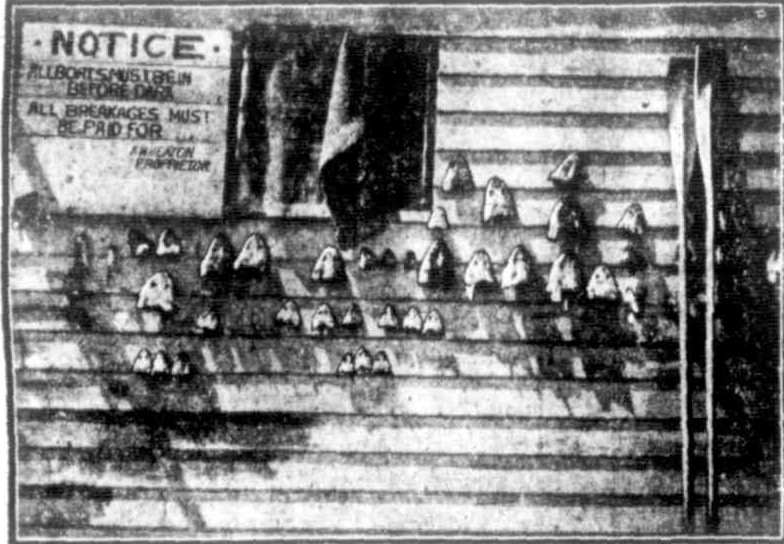
IT PAYS TO ADVERTISE.— This is how a Narrabeen boatman advertises the good fishing grounds there. Proof of this is the gallery of fish-heads nailed to the wall.—'Evening News.' NARRABEEN'S "HEADS" ON THE LONG BAY "FRONT" WRITING HOME. (1923, April 17). Evening News (Sydney, NSW : 1869 - 1931), p. 12. Retrieved from http://nla.gov.au/nla.news-article118844660
Narrabeen and Deewee-deewee were the aboriginal names of the well-known lakes near Manly. "Narrabeen" was the swan (Cygnus stratus) and"deewee-deewee" was a widely spread name of the little grebe (Podlceps Minor), well known in England and here also as the "dab-chick." On my first visit to the Narrabeen Lakes in 1872, they were covered with swans and dabchicks. Five aboriginals who were camped there called the honeysuckle (the"wallum") "gnarrabeen," but they were not speaking the old Beeahlba dialect of the Sydney blacks. They knew more Kamilroi, and the Awaba (Ahwabah) of Port Macquarie. Parramatta comes from "parra," the eel, and "matta," water, eel water, both words In the old Sydney dialect. At Moreton Bay and Frazer Island the eel was "yulu," a name also common to the porpoise. ABORIGINAL NAMES. (1921, November 9). The Sydney Morning Herald (NSW : 1842 - 1954), p. 16. Retrieved from http://nla.gov.au/nla.news-article15962804
A BIG HAUL OF FISH. Wellington anglers have been boasting of their big hauls of fish during the Easter holidays, but their catch cannot compare with that brought to land by two Wellington amateur fishermen who tried their luck in the salt water whilst holidaying in Sydney for Easter. They had heard that Narrabeen Lakes were teeming with finnies, and all they had to do was to haul the fish in without any bait on their lines. One of the fishermen was a well-known Wellington bank official, who caught three bream, the whole three of which put together did not turn the scale at six ounces. He got disgusted and wound up his lines. The other fishermen hauled in two big eels each about two feet long, and his lines were in such a tangle as to become almost useless. He also wound up his lines and cursed Narrabeen Lakes, and both returned home, vowing to stick to the good old Macquarie River in future. A BIG HAUL OF FISH. (1924, April 28). Wellington Times (NSW : 1899 - 1954), p. 6. Retrieved from http://nla.gov.au/nla.news-article137377295
By far the most curious eel story connected with Narrabeen and its tributaries is the tale of a 'sea creature' that sounds like a large eel but may not be:
OVERSIZE EEL. Auckland (N.Z.) sportsmen who boast of the large conger eels they catch, and their Maori brethren who know how to catch river eels with a tangle of flax surrounding a piece of meat or bird at the end of a short line, and Mangrove Creek. Hawkesbury (N.S.W.). fishermen who talk of huge, eels that pulled their boats miles against a current will not feel so cocky, after reading the following: In 1900 a conger eel which weighed 148lbs and was 8ft 8in long, was stranded at Snettisgham (Eng.), and one weighing 100lbs, at 7ft 9in long, was washed ashore at Trimingham, Norfolk. (Eng.) in 1928. Now trot out your Australian sea serpents. ROD AND LINE . (1930, September 17). Referee (Sydney, NSW : 1886 - 1939), p. 23. Retrieved from http://nla.gov.au/nla.news-article131165453
SEA SERPENT? NEAR NARRABEEN - What is claimed to be a sea serpent was seen off Narrabeen. It was about 70 feet long, with a tail resembling a large eel. The mysterious visitor was observed by Mr. and Mrs. Parrington, who first took it to be the mast of a ship, but observation with field glasses quickly dispelled this idea. SEA SERPENT?. (1930, November 21). The Burrowa News(NSW : 1874 - 1951), p. 4. Retrieved from http://nla.gov.au/nla.news-article102365609
Although large eels are certainly found in the area, according to this perhaps 'fish tale' they were throughout the Pittwater area with one large one caught at what was then known as the 'Black Swamp', now Kitychener Park and Mona Vale Golf Course, at Mona Vale:
OUR BIG EELS
"Izaak W." says: —
I read with interest a statement in "Tite Sunday Sun" that an eel weighing 22lb. was caught in a waterhole near Goulburn. Further, it may Interest you to know that within the past few years three eels caught in Kangaroo Valley weighed respectively 231b., 201b. and 18lb. An eel caught in a creek near Grafton in 1912 weighed 27lb„ and one caught in a swamp, now part of Mona Vale golf links, in 1926, weighed 24lb. These big eels play the very devil with perch and other good fish, and should be killed wherever they are found. I have been after one cunning old fellow for vears He "owns" a water-hole up bevond Moss Vale, and. from close-ups I've had of him. I should be surprised if he doesn't scale over 301'b. He can straighten or break large snapper hooks. BUNDLE OF LETTERS (1934, March 7). The Sun (Sydney, NSW : 1910 - 1954), p. 13 (LAST RACE EDITION). Retrieved from http://nla.gov.au/nla.news-article230540768
And while on curious and curiouser eel notes:
ANTIQUARIAN EEL - An eel has been taken from the Shannon (Inland) which was coiled around an old sword, of Scottish pattern. It is thought to be a relic of the army of Berwick, which crossed the Shannon at that point after the battle of Aughrim, in 1691. ANTIQUARIAN EEL. (1906, May 19). The World's News (Sydney, NSW : 1901 - 1955), p. 31. Retrieved from http://nla.gov.au/nla.news-article128273233
And one of the many ways we ate them:
EEL BROTH.
Half a pound of eel, three pints of cold water, half a 'small onion, two or three sprigs of- parsley, one bay leaf, two cloves, salt and pepper.' Wash clean and skin the eel, then cut it into small pieces and put them in a slowpan. Add the water, onions, parsley, bay leaf, cloves, and a little salt and pepper, and simmer gently for an hour and & half, a basin, let it stand until' cold and remove every particle ox fat. Reheat in small quantities as required. EEL BROTH. (1914, March 13). The Gundagai Times and Tumut, Adelong and Murrumbidgee District Advertiser (NSW : 1868 - 1931), p. 3. Retrieved from http://nla.gov.au/nla.news-article129670230
In 1905 (Ref. map Parish of Narrabeen ) there was only one Narrabeen Creek, at the present site of Deep Creek. It was In 1906 when estate agent Henry Halloran advertised the "Warriewood Estate" for sale for the first time, that he decided to name a second creek, "Narrabeen Creek", which ran right across his estate starting near Mona Vale Road and finally reaching present Mullet Creek. Over the years this second naming, in a different location, caused considerable confusion. - Courtesy Shelagh and George Champion.
TOMATOES OF QUALITY. SUCCESSFUL METHODS AT WARRIEWOOD. Rarely if ever before within the metropolitan area have better class tomato plants been seen than those which are now growing luxuriantly in the glasshouses of Messrs. Brand Bros., of Warriewood, near Narrabeen. Yesterday afternoon, when a representative looked in to see how the plants were shaping, the tomatoes were most impressive. In leaf and stem growth, In the number and strength of the bud bunches, and also in the setting, quality, and colour of the fruits' the plants were splendid. The growers have done fine work this season during a period which has brought disaster to many outdoor and glasshouse workers in tomato culture. The warm, sheltered position of their big houses, and their expert handling has contributed much to the result. TOMATOES OF QUALITY. (1929, August 28). The Sydney Morning Herald (NSW : 1842 - 1954), p. 13. Retrieved fromhttp://nla.gov.au/nla.news-article16579174
Frosts (1943) and bushfires(1941 & 1952) marked challenging years. There were also other hazards to contend with: BODY AMONG SPIDERS . James Carr, believed to be more than 90 years of age, was found dead yesterday in a hut infested with funnel-web spiders. His body was found on his bed in a small hut in which he lived in Warriewood Road, Warriewood. BODY AMONG SPIDERS. (1949, March 26). The Sydney Morning Herald (NSW : 1842 - 1954), p. 5. Retrieved fromhttp://nla.gov.au/nla.news-article18108674
And record crops and prices:
The production of tomatoes under glass is becoming highly competitive. New houses are being continually erected. It is estimated that the equivalent of 4000 standard houses is now being used for tomato culture in New South Wales. In other words, about' 130 acres of tomatoes are grown under glass annually. The principal centres of production are Buronga, on the Murray River opposite Mildura, where the equivalent of about 400standard houses have been erected, and in the Mona Vale-Warriewood district. Most Important The latter area Is by far the more important, the equivalent of about 3000 standard houses being used for tomato culture.
Disease control is one of the glasshouse growers' greatest problems. Soil-borne diseases, especially Pusarium wilt and eel worm, will put growers out of business unless early and systematic control measures are adopted. Steam sterilisation and the treatment with Chloropicrin will do much to keep the soils healthy. Some growers have their own steam sterilising plants and others depend on contractors. There are three systems: The spike harrow system, the inverted pan and the buried drain tile system. The first-named is commonly used In this country. Spike Harrow Each spike harrow is allowed to remain in the soil until the necessary temperature of 180 deg. F. is secured at the required depth. Disinfection is obtained to a depth of 10 in. to 12in. In from 7 to 10 minutes with a boiler pressure of 75to 100 1b.The soil needs to be well worked with a moderate moisture content before steaming. After withdrawal of the harrow, it is advisable to cover the soil with sacking or a tarpaulin for half an hour. The method of using Chloropicrin is to make holes 4 in. or 5 in. deep and about a foot apart and pour about l/5th oz. of fluid into each hole and then tamp the soil down. Cover the moistened soil with moist bags for several days. Chloropicrin gives rise to an irritant gas and precautions have to be taken when applying it to the soil. Distributors have special injectors for applying soil disinfectant which are thought to be efficient and simple of operation. Market Garden. (1954, March 26). The Farmer and Settler(Sydney, NSW : 1906 - 1957), p. 29. Retrieved from http://nla.gov.au/nla.news-article122988962
During the 1960s market gardening declined although most of Warriewood, apart from some pockets of light industry, and nurseries was zoned as a rural until 1991 when the state government permitted subdivision. By 1995 the resulting runoff into Narrabeen creek had made it seriously polluted and in danger as the aorta of Warriewood valley. Dragonfly Environmental were employed to install a Detention Basin at Narrabeen Creek. A small wetlands has been established to improve the quality of the creek's water at its southern reaches. Today volunteers from the Coastal Environment Centre monitor the health of this creek.
For the decades leading into this saving of the wetlands of Warriewood valley, and their chirruping creeks, David James, who was among many there at the coal front, kindly provides us with the decades between 1974 and 2006:
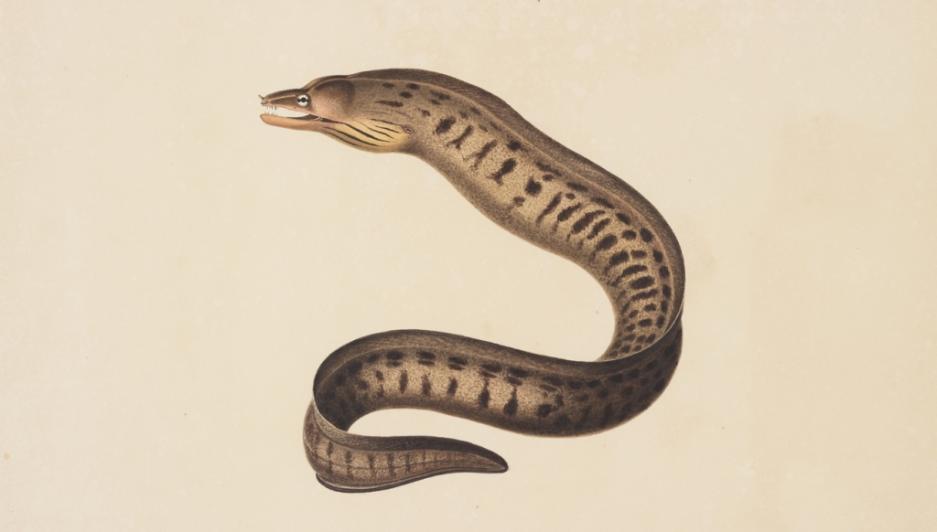
From; Volume 07: Natural history drawings of fish, ca. 1839-1867 / by James Stuart - Images No.: a 5187004 and a5187013, courtesy Mitchell Library, State Library of New South Wales
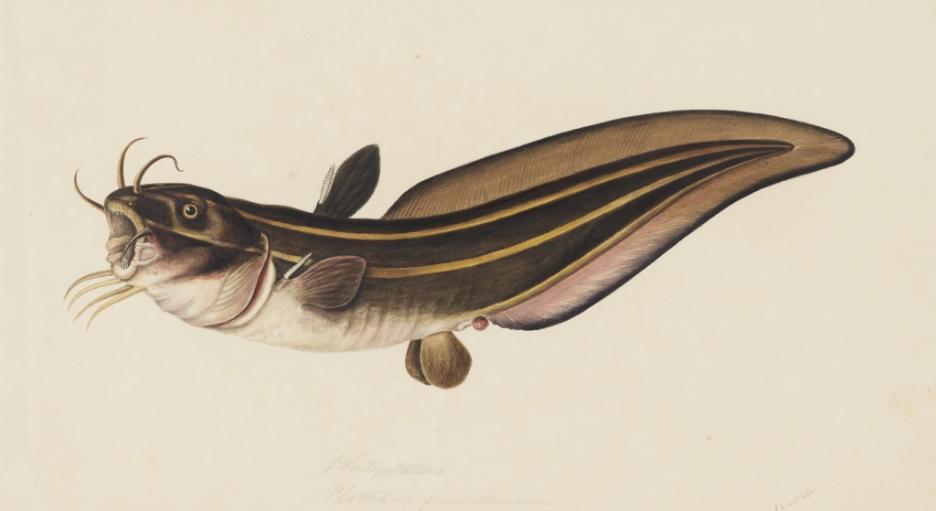
A Short History of community involvement in favour of environmental issues/campaigns in and around Narrabeen Lagoon - 1974 to present.
By David James - former Mayor and Councillor of Pittwater
The formation of Narrabeen Lagoon Committee occurred in 1977 to combat a proposal for a seaplane base on Narrabeen Lagoon. Executive members were Mark Edwards, Phil Colman, David James, Maurie Gunter, Trevan and Di Johns. A public meeting at Mona Vale organised to draw attention to the state of the lagoon system and the need for its protection was attended by 472 people many of whom joined the Committee.
The Work of NLC included;
We prepared the first Lagoon Plan of Management, subsequently put to Warringah Council for adoption. It was accepted as an initial plan pending the subsequent development of the first plan of management by Council. Many of its precepts were incorporated into the later Council Plan.
Our work led to the establishment by Warringah of Narrabeen Lagoon Systems Advisory as a S.530A committee of Council, subsequently broadened out to advise also on Dee Why, Curl Curl and Manly Lagoons.
In 1979, we organised on behalf of the Lagoon Committee, a seminar on Urban Stormwater Management held under the auspices of Warringah Shire Council to advocate the preservation of natural creek lines, rather than concrete floodways and structures until then under active consideration for the stormwater drainage of the mooted urbanisation of Warriewood Valley. Subsequently we prepared a detailed proposal that I took to Planning and Environment Minister Paul Landa in respect of the forthcoming development of Warriewood Valley that called for preservation in a natural state of Narrabeen, Fern and Mullet Creeks. This was agreed to and then formed the basis of the urban planning of the Valley.
In order to combat widespread in-filling of low-lying areas of floodplain in Warriewood Valley, detailed information was prepared and put before officials of the Planning and Environment Commission and Minister Paul Landa. This resulted in promulgation of Interim Development Order 138 which banned and made illegal these adverse activities.
Advocated for the establishment of a State Government Inquiry into the health of Narrabeen, Dee Why and Curl Curl Lagoons. This was accepted by Minister Landa who instructed the State Pollution Control Commission to conduct the comprehensive inquiry by Dr. Jo Moss, which concluded, in part, that Narrabeen Lagoon could benefit from a carefully planned program of dredging.
Conducted a campaign to shut down Kimbriki Tip based on fears of potential leachate pollution emanating from the Tip into Deep Creek thus impacting on Narrabeen Lagoon. Subsequent involvement in direct action at the tip led to major improvements to its operation to satisfy concerns about long term legacy pollution issues.
An important offshoot of the Kimbriki issue involved Occupational Health issues that were revealed in the subsequent Manly Court hearings brought by the Metropolitan Waste Disposal Authority and later, in the NSW Parliament, culminating in the development and adoption by the NSW Government of the Occupational Health and Safety Act 1979, the first such legislation in Australia.
Also, Warringah Council through its Shire Engineer Lindsey Browne responded very well to the deficiencies brought to light by the action resulting in a complete upgrade and reorganisation of Tip Management that has brought the tip up to a standard that has, in large part (if not completely) addressed concerns regarding the potential for medium and long term effects on the health of Deep Creek and the Lagoon.
Another major campaign of the NLC sought to have all remaining undeveloped bushland in Narrabeen Lagoon catchment acquired and set aside into public ownership as a National Park in this way taking up and building upon the earlier work of the previous Narrabeen Lagoon Regional Park Committee (Vic Workman, Maurie Gunter et al). In time, this advocacy led on to the dedication, free of charge, by owners Dainford P/L of 850 hectares of their bushland holding that was indeed transferred into public ownership and incorporation into Garigal National Park.
Continuing advocacy for protection of the lagoon catchment led onto the promise in 2008 by then Lands Minister Bob Debus to add into Garigal a further 430 h.a. of vacant Crown bushland.
Opposed the destruction of the Warriewood Wetlands for urban development and drainage in campaigning over 17 years, initially by the NLC but subsequently by the Bi-Centennial Park Committee that led in time to fulfillment of the promised rezoning of the wetland to local open space and ultimately purchase by Pittwater Council and incorporation into the Bi-Centennial Park.
Obtained from Minister Paul Landa an agreement to preserve 27 h.a of Warriewood Wetland as environmental open space. However, this agreement was not honoured before Minister Landa was transferred to another portfolio. This meant that work had to be done which ultimately resulted in the promised rezoning under IDO 142 by the new Minister of Planning Eric Bedford.
That however was not the end of the matter as Warringah Council had no interest in acquiring the wetland from its owner Henry Roth (who to his great credit had privately made a promise to not seek to develop it in recognition of its high conservation value).
The matter was only resolved upon the emergence of Pittwater Council, which under General Manager Angus Gordon served the necessary resumption orders. Final protection and resolution was reached in a half day hearing in the Land and Environment Court for the sum of $4.76 m.
In 1978 a small group of dedicated environmentalists formed the idea following the just-announced-proposed urbanisation of Warriewood and Ingleside an urgent need had arisen to protect parts of the Warriewood escarpment and in particular the Mullet Creek catchment with linking up continuous strip of public bushland and parkland running from Ingleside all the way to the ocean outlet of Narrabeen Lagoon.
This group, called itself the Bi-Centennial Park Committee and comprised Geoff Mitchell as its founder and included Ian and Denise Morgan, Rob Howard and John Rutherford, John and June Smith, David and Diana James and Ray and Heather Kentwell and others.
With the thought of the forthcoming 1988 Bi-centenary celebration in mind that this would be a wonderful gift to the nation, a campaign was developed that led to adoption of the Coastal Walkway (under Trish Giles leadership) and the Warriewood Wetlands by the Commonwealth of Australia as a gift to the nation, (notwithstanding that the wetland was at that time still in private ownership).
The first element of the Ingleside to the Sea Bi-Centennial Park idea was achieved in the agreement in 1979 by Minister for Lands W Crabtree (at the suggestion of Member for Wakehurst Tom Webster and David James) that the redundant Mullet Creek Crown Water Reserve along the length of Irrawong Rd could be a useful start to this project.
Then the addition of the Warriewood Wetland detailed above and finally the purchase by Pittwater Council (once again under General Manager Angus Gordon) of the Heydon Land (that comprised the waterfalls and upper left and right Mullet Creeks) in 2005 meant that what had seemed an impossible dream in 1988 became a reality in the relatively short space of 27 years.
Finally there is the matter of how the protection of Warriewood Escarpment was achieved.
In 1999 a proposal had been brought to Pittwater Council by Healesville Holdings seeking to develop 12 residential lots connected on elevated concrete roads on a large swathe of the escarpment on the steep slopes north of Mater Maria school, to be known as Burrawang Estate. Local residents, aghast at the perceived environmental and aesthetic impacts of this proposal decided to form the Warriewood Escarpment Committee so as to ensure its protection as an environmental buffer and a natural backdrop to all the urban development occurring on the valley floor below.
David Palmer, David James, Marita Macrae, Jim Revitt, Phil Walker, Garry Harris, David Mason, Karen Nippard, Shelagh Atkinson and Robin Plumb formed the Pittwater Escarpment Committee in 1999 and campaigned vigorously to gather community support and the attention of Pittwater Council to take action to avert the environmental destruction that would be an inevitable consequence on the scenic and natural qualities of the escarpment development.
A highlight of the campaign was a public meeting held at Pittwater RSL in February 2000 where Pittwater Councillors including Mayor Giles were convinced of the need for protection.
Admirable support was soon forthcoming from Mayor Trish Giles, her fellow Councillors and General Manager Angus Gordon, who by resolution of Council voted to support preservation of the escarpment in its vital natural condition. Mayor Giles, supported by her Councillors initiated an environmental levy for a fixed term to fund any land purchase that might be required. In October 2000 agreement was reached with Healesville Holdings to exchange Council’s former sanitary nightsoil disposal area at Walter Rd Ingleside for the Burrawang Ridge Estate, thus securing a major part of the escarpment.
Subsequently, beneficial agreements were also made by Council with the Diocese of Broken Bay, owners of Mater Maria School (in the middle escarpment) and the Uniting Church (southern end) that stand to the eternal credit of all these entities not least being the visionary and inspired efforts of the staff of Pittwater Council, who conceived and negotiated the necessary land transfers, then put these proposals to the elected Councillors who enthusiastically agreed by resolution.
Finally in June 2006, the majority of the bushland on the Warriewood escarpment had now come under the control of Pittwater Council to be dedicated as a nature reserve.
The various community campaigns outlined in this Short History had the good fortune to coincide at a time of thoughtful and responsive local and state governments which greatly assisted the successful transfer into public ownership and thus protection of 1020 hectares of pristine bushlands in Narrabeen Lagoon Catchment. The history shows how inspired community effort spread over 37 years, was able with good argument, to achieve such great things as are beyond all our previous imagination.
David James
16 October 2014
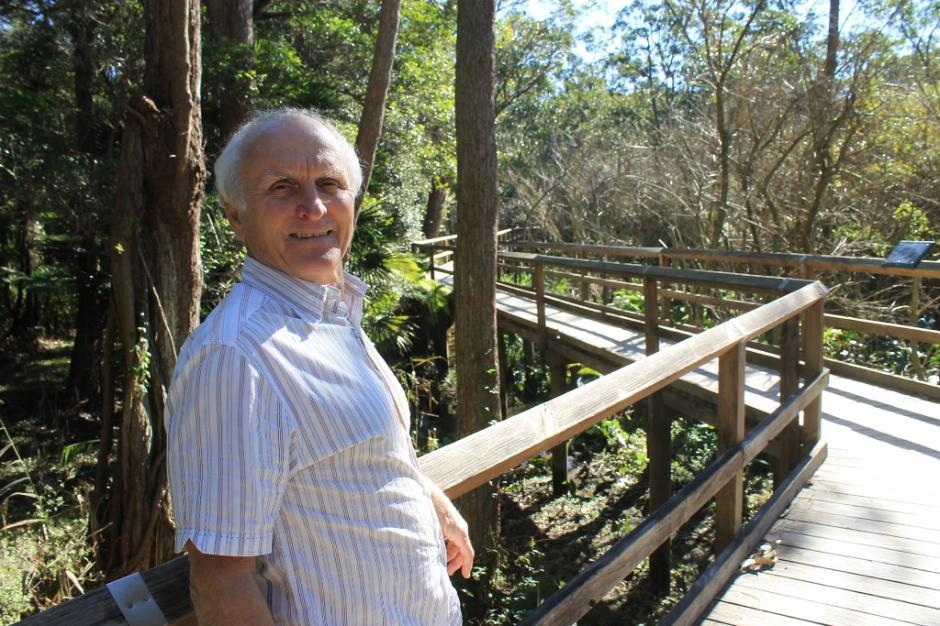
David James - OAM
To 2014:
Bushcare Major Day Out and $250k Wetlands Grant - Irrawong Reserve
Rare Giant Burrowing Frog Discovered in Pittwater -Pittwater Environment Foundation and Pittwater Council bring you one of the best Environmental news stories for this year
Mullet Creek and Mullet Care Bush Care Project Update
A Stroll Through Warriewood Valley with David James OAM - A Living Wetland
Wetlands by Phil Colman, co-author of Exploring tidal waters on Australia’s temperate coast'
Wetlands ‘ain’t wot they used to be’ and will change tomorrow by Dr Peter Mitchell, co-author of Exploring tidal waters on Australia’s temperate coast'
Jim Revitt Honoured – Spring 2010
Pittwater Council has recognised the contribution of one its founding fathers, the late Jim Revitt, by unveiling a commemorative walk named in his honour.
Jim Revitt, who died in November 2009 at the age of 78, is widely acknowledged as being one of the leading community figures in the battle to create a separate local government area for the people of Pittwater.
Although choosing not to become an elected Councillor, Jim Revitt played a leading role in various community organisations and grassroots movements, including the Save Mona Vale Hospital Committee, the Pittwater Escarpment Committee, the Elanora Heights Progress Association, the Pittwater Residents Association and the Pittwater Natural-Heritage Association.
The walkway, in Irrawong Reserve in Warriewood, was named the ‘Jim Revitt - Irrawong Walk’ at a special ceremony on Friday 22 October. Jim Revitt’s widow Rosemary and his two sons David and Damian unveiled a special commemorative sign on the walkway, accompanied by Mayor Harvey Rose, Pittwater Councillors, community members and senior staff.
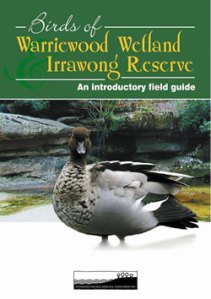 Jim had been a PNHA supporter for many years and played a pivotal role with PNHA in the Pittwater Escarpment Committee to prevent subdivision for residential development on the Warriewood Escarpment. The high quality of PNHA’s Introductory Field Guide to Birds of Warriewood Wetland and Irrawong Reserve is due to Jim, who envisaged a much better book than we would have been able to produce with our meagre grant funds for that pur-pose. With David James, he convinced the son of the former owner of the Warriewood Wetland, Henry Roth, to make a generous donation towards its production. Sales of that book have now resulted in about $17 000 going to Pittwater Council’s conservation of the area.
Jim had been a PNHA supporter for many years and played a pivotal role with PNHA in the Pittwater Escarpment Committee to prevent subdivision for residential development on the Warriewood Escarpment. The high quality of PNHA’s Introductory Field Guide to Birds of Warriewood Wetland and Irrawong Reserve is due to Jim, who envisaged a much better book than we would have been able to produce with our meagre grant funds for that pur-pose. With David James, he convinced the son of the former owner of the Warriewood Wetland, Henry Roth, to make a generous donation towards its production. Sales of that book have now resulted in about $17 000 going to Pittwater Council’s conservation of the area.
Jim Revitt’s widow Rosemary and his two sons David and Damian unveiled a special commemorative sign on the walkway, accompanied by Mayor Harvey Rose, Pittwater-Councillors, community members and senior staff.
Jim had been a PNHA supporter for many years and played a pivotal role with PNHA in the Pittwater Escarpment Committee to prevent subdivision for residential development on the Warriewood Escarpment. The high quality of PNHA’s Introductory Field Guide to Birds of Warriewood Wetland and Irrawong Reserve is due to Jim, who envisaged a much better book than we would have been able to produce with our meagre grant funds for that purpose. With David James, he convinced the son of the former owner of the Warriewood Wetland, Henry Roth, to make a generous donation towards its production. Sales of that book have now resulted in about $17,000 going to Pittwater Council’s conservation of the area. - Pittwater Natural Heritage Association - Spring 2010 Issue 54 - PNHA News - Retrieved from: http://pnha.files.wordpress.com/2010/12/pnha-nl-november-2010-154.pdf
In this series of Pittwater Online History pages - Pittwater Watery Environs - Seafood Feasts:
Narrabeen Prawning Times - A Seasonal Tide of Returnings
Oystering in the Pittwater Estuary - Oyster Kings and Pearl Kings and When Not to Harvest Oysters
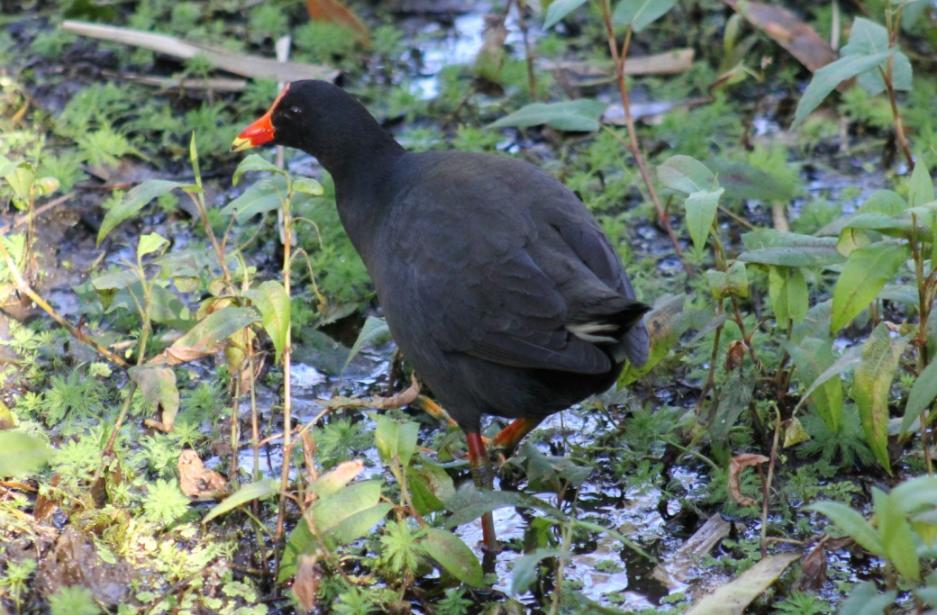
Extras:
PEEPS FROM AN ABORIGINAL GIBBER GUNYAH.
(By W. J. Walton, in 'Mankind.').
' 'Tis pleasant from the peepholes Of retreat to peep at such a world.'— Cowper.
In the late eighties the district of Oxford Falls, Middle Creek, South Creek, Wheeler Creek and the country forming part of the southern boundary of the Narrabeen lagoon, was, for all intents and purposes, in much the same virgin state as when Cook passed along the coast on his memorable voyage up north. Much of the surrounding country was wild and mountainous, very heavily timbered in places, affording some security to the rock wallabies, which, at that time, were not quite extinct. It was a land of gullies and waterfalls, having magnificent Views, of line seascapes, here and there intersected' by a number of small creeks, which, joining the main creeks, drained a great part of the watershed of the Narrabeen Lakes. In the springtime this God-made country, made joyous with the songs of birds, had a burst of efflorescence, a kaleidoscope of colour probably unsurpassed in the Australian continent. Towards the end of the year the Christmas Bells —'Blandfordia nobilis' and 'Bland-fordia florabunda' — grew in thick patches, the nodding bells waving in the wind like the wheat in a wheat field. The Christmas Bush — 'Cerato-petalum gummiferum' — with its enlarged red sepals, came to announce that Christmas was near. Through the seasons the wealth of flowering trees and plants followed each other in quick succession; Boronia, Waratahs, Flannel Flowers, Epacris, with many others, made the wilderness of rocks and sand to blossom as the rose. Besides its wonderful flora, which, now that it is almost too late, is being regarded by the scientific world as being worthy to rank amongst the botanical treasures of the world, it contained many evidences of men, manners and customs of a bygone race.
Scratched and punctured on the naked rocks for the purposes of the native ceremonial are the petroglyphs of a primitive stone age race. Do not smile — it is from such humble beginnings that all art and culture have sprung. From a retreat where is was usual in those days of bush ramblings to spend the night, a case — a stonehouse or 'gibber gunyah' of the blades — the eye rests on what further down on the opposite side of the valley is an old aboriginal ceremony ground. Viewed at night, when the moon is obscured by clouds, it has a weird, uncanny look. The spindly trees standing sentinel on the ridge at the back of the rock saddle, look like the ghosts of the dead race.
In Governor Phillip's time there is reason to think that a great part of this Wheeler Creek area was an important aboriginal ceremony ground. Besides the principal group of rock carvings, there are spread over a wide extent of country other smaller groups, some of which after the lapse of years are difficult to locate. Many have been effaced, others are covered with soil and the encroaching bush. There are many isolated carvings scattered about, like the sacred circles, emus, fish and eels, or the large snake on a rock near the waterhole. All these to the native mind had a deep spiritual meaning.
The snake is very prominent in the many myths and legends of the Aborigines. He always lives in a waterhole. The stories about him may vary, but the intruder in his home is usually swallowed. Little of a reliable nature is known of the ceremonial life of the Aborigine in the Manly district; still, it is possible by the study of their rock carvings and customs elsewhere to get a fair insight into the daily lives of these people. The petroglyphs on the main group show they were hunters. The tracking and capture of the kangaroo are shown; there are footprints of the marsupial; following those are the footprints of men. Two kangaroos have spears in their necks. Below, a little distance on the sloping rock, are the hunters who have thrown the spears. One scene is portrayed by two men; they are having a battle royal. In the hand of each of the men is a big waddy, evidently in vigorous use. What is was all about we do not know — probably it was over a woman. Here again footprints were once to be seen: they were arranged in such a way as to indicate the progress of the battle and the flight and defeat of the smaller man. As is usual in most groups of rock carvings, the food supply is well represented. Fish, large rays and the food animals are all there. A deity without radial lines or a circle completes the group. The light side of the black's life Is represented by a number of large shells threaded on a string. In shape it resembles a large necklace. Amongst all the aboriginal rock carvings in Warringah Shire there is none like it. It is complete even to the loop by which it was held in the hand. Its use was to produce primitive music or beat time at the native dances.
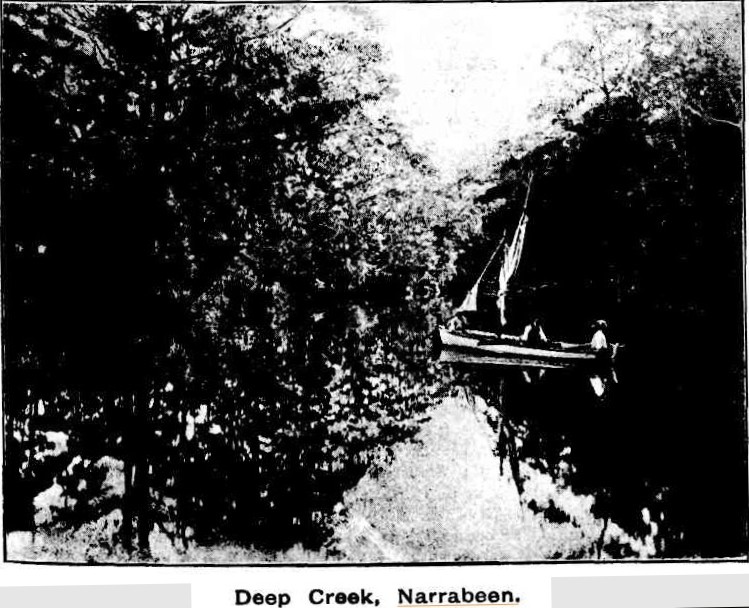
Above: Deep Creek, Narrabeen. Contemporary Journalism. (1893, November 25). Illustrated Sydney News (NSW : 1881 - 1894), p. 15. Retrieved from http://nla.gov.au/nla.news-article63672414 Below: Narrabeen Lakes, No.a116487, courtesy State Library of NSW
.jpg?timestamp=1410588420749)
A few hundred yards northwards on the promontory, whose end commands a fine prospect of the Narrabeen Lakes and the surrounding country, there are carved on a dome-shaped rock the figures of two men; in the years that have gone, they had grotesquely shaped legs. Campbell, who saw the group when it was badly weathered, describes the men as having the appearance of being clothed with a flowing skirt. A few yards further away area school of fish and a banded eel. At the present time they are covered with soil. The layout of the principal group, north by south, together with the absence of water, would suggest the ground was not dedicated to the man making ceremony. In all probability, from the presence of so much of the blades' food supply, it is associated mainly with food ceremonies. In the old aboriginal life this, like the totemic ceremonies, took place annually; at these times the women and children were always sent to someplace where they could see nothing, but quite close enough for their singing to be heard during the ceremony. At times the sanctity of the performance required their removal altogether. To all uninitiated persons the ceremony grounds were taboo.
At seasons of bush plenty, food ceremonies, at which songs of hunting and fishing were sung, followed by sacred dances, might last over a period of several months, ending up at the last phase of the moon with a great deal of feasting and singing. At night, seated round a warm wood fire — for though the day has been hot, it is now rather chilly — we watch the stars come out one by one. In these places, away from the dust and glare of the town, they shine like lamps. What thoughts crowd the mind! We think how on cold nights the, fire must have been the black's best friend, and how, like all primitive people, he had his views and legends about the stars. In and amongst the nebula; of the milky way may be seen a dark shape. It is the emu of the aboriginal folk-lore. The aboriginal child, like his elders, was very much afraid of the dark. Is it too much to say, on a night like this when the stars seem to be close to the earth, that his parents, instead of a nursery tale, would point to the sky and tell him the ancient story of how the emu once flew in the sky, and how an ancestral deity threw his broad bladed tomahawk at the bird and brought it down to earth.
Seawards, towards the eastern end of the ridge on which is the principal group, are some mundoes; they show a phase of the spirit- beliefs of the blacks. The spirit belief is ingrained in the life of an aboriginal, so that anything of an uncommon nature — a thunder storm or a natural phenomenon — may cause his teeth to chatter with fear. He lives in a world of ' supernatural influence, of magic and mystery. As a child, when he is born he is rubbed with ashes and fat, in the fear and belief that if it is not done he would remain white and become a spirit. Even at his death his body must not touch earth, and a fire must be lit on or about his grave to enable the spirits who caused his death to warm themselves without going near the encampment fires. In his initiation and other ceremonies he learned the names of spirits — good and evil — how they came on earth; about spirit animals, of the prehistoric life, of the ancestral deities who created the tribal area and made the laws; how in histotemic system he was originally a bird or an animal or other living creature; just as he carried on his back many scars made by the 'mardi' or stone knife, setting forth his true character as a man, warrior and hunter, so the rock carvings on the old ceremony grounds record the ancient beliefs, ritual and life history of an age old vanished race. PEEPS FROM AN ABORIGINAL GIBBER GUNYAH. (1932, May 24). Dungog Chronicle : Durham and Gloucester Advertiser(NSW : 1894 - 1954), p. 6. Retrieved from http://nla.gov.au/nla.news-article141142328
MULLET CREEK BUSH-CARE GROUP DAY 1 by Pittwater Ecowarriors - (John Illingsworth)
Published on 6 May 2013
The first volunteer day in the rescue of Mullet Creek. "Incantation" courtesy of www.agostinomusic.com - duo Agostino guitars.
Please join this bush-care group to save the Mullet Creek catchment See www.pittwaterenvironmentalfoundation.org.au or contact Pittwater Council Bushcare.
A Short History of community involvement in favour of environmental issues/campaigns in and around Narrabeen Lagoon - 1974 to present by David James, 2014 Eeling in Warriewood's Creeks - threads collected and collated by AJ Guesdon, 2014.